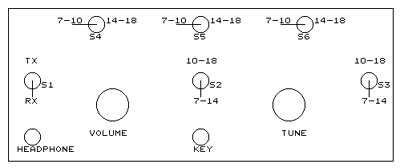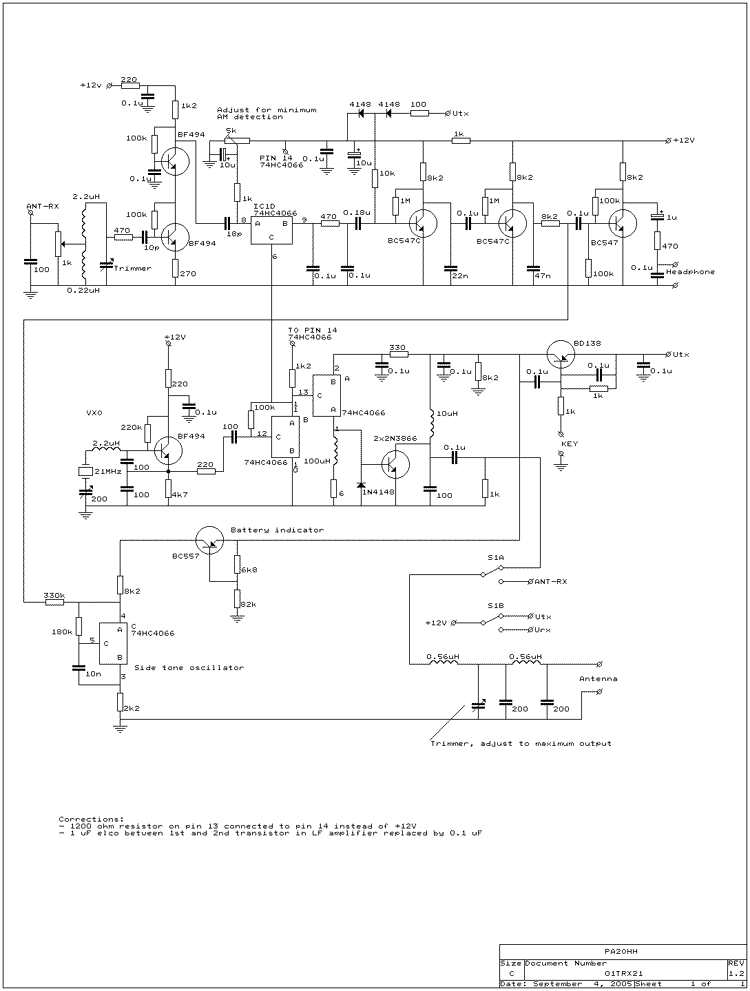
"HappyHolidays TRX"
A four band VXO
tuned
1 watt QRP CW transceiver

A simple, solid rig for outdoor use during Holidays.
More
is possible with this solid QRP rig than you should expect.
Just try it and
do not give up soon!
The "HappyHolidays" is a 4 band 1 watt VXO controlled transceiver, with similar performance but with more recent components and better suppression of AM detection and also intended for Holiday use.

Circuit diagram
big diagram
Mixer
The mixer is one C-mos switch of the 74HC4066 (Do not use a
HCT!!!). It works perfect!!!
Adjust the 5k potmeter for minimum AM detection
of strong broadcast stations. If you do not have an AM signal available for
adjustment, set it to centre position.
LF amplifier
Just a simple 3 transistor amplifier. The first
transistor is muted during TX via the 10k resistor. The LF amplifier is
optimized for CW reception with a low LF beat tone. The selectivity of the ear
is very good for low audio tones up to 600 - 800 Hz, a CW filter is not really
necessary.
Select the value of R1 (1200 ohm) so that in receive mode, the
supply voltage of the 74HC4066 (pin 14) is approximately 5 V.

The LF amplifier is optimized for CW
but it is not
a very narrow CW filter.
| Tuning ranges without the optional series inductors | ||
| Crystal Frequency (kHz) |
Minimum Frequency (kHz) |
Maximum Frequency (kHz) |
| 7025 | 7024.3 | 7026.2 |
| 10125 | 10123.7 | 10126.5 |
| 14050 | 14048.2 | 14051.9 |
| 18080 | 18076.6 | 18080.4 |
| Tuning ranges with the optional series inductors | ||
| Crystal Frequency (kHz) |
Minimum Frequency (kHz) |
Maximum Frequency (kHz) |
| 7025 | 7021.1 | 7023.8 |
| 10125 | 10118.4 | 10123.0 |
| 14050 | 14039.9 | 14045.9 |
| 18080 | 18070.6 | 18076.4 |
Transmitter part
The VXO signal is buffered by a C-mos switch and
amplified to 1 watt by a transistor 2N3553 or as I did, 2 transistors 2N4427 in
parallel. The 1k ohm resistor makes the amplifier more stable when mismatches
occur. The 0.68 uH / 180 pF and 0.47 uH / 68 pF are tuned to the second harmonic
of 7 resp. 14 MHz for extra suppression.
Options
How to work with the Happy Holidays
During transmission the VXO
frequency has to be identical to that of the other station. When receiving, it
needs to have an offset of 300-800 Hz, depending on the beat tone frequency you
want to listen to. Therefore, it is necessary to tune the VXO approximately to
zero beat with the other station just before the end of its transmission. When
receiving, tune the VXO to the desired offset. In receive mode, tune the VXO
offset frequency to the other side of the received signal if there is less
interference on that side. After a few QSO's you will be completely used to how
you have to operate the rig.
Performance
Sensitivity: 0.6 uV signals are readable
3rd
intercept: more than 20 dBm
Spurious responses of the receiver: Better than
-90 dB
RX current: 10 mA
Transmit power: 0.5 W at 9 V; 1 W at 12 V; 1.5 W
at 13.5 V
Harmonic suppression: below 30 MHz: 43 dBc, above 30 MHz: 60
dBc

Position of switches and other controls

Simple key (pushbutton in an old filmbox), foldable
headphones, batteries and antenna.
PHOTOGRAPHS

Inside the box. The VXO is screened from the
rest of the
circuit by a verical piece of PCB.

Both sides of the unetched PCB are fitted with components
21 MHz version with RF preamplifier
Why
an RF preamplifier
The RF amplifier improves the sensitivity: 0.3 uV
signals are readable.
But that is not the only reason to add the amplifier. A
second, even more important reason is that it attenuates the Local Oscillator
leakage from the mixer to the antenna input by 20 dB. This oscillator leakage
may cause problems if you use a power supply instead of batteries, mostly on the
higher bands.
A loud 50 or 100 Hz audio tone is the result of too much Local
Oscillator leakage. Without the amplifier, the 21 MHz version had this problem.
With the amplifier there was no hum anymore and the sensitivity was very good.

Schematic diagram of the 21 MHz version with RF
preamplifier
big diagram